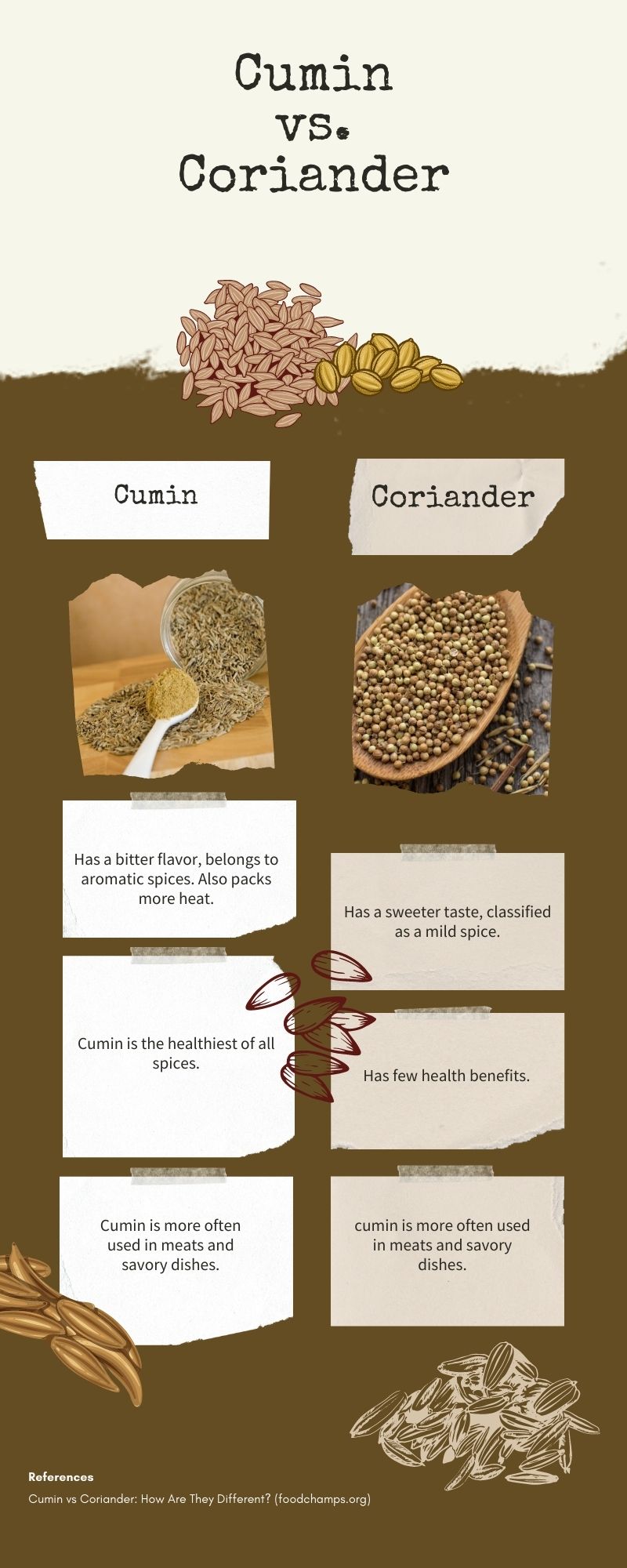Cumin has a smoky, earthy flavor, while coriander has a light, citrusy taste. While they are part of the same family and share some similarities, they have different flavor profiles. Additionally, cumin is native to the eastern Mediterranean region and western Asia, and coriander is native to the Mediterranean region, including Southern Europe, North Africa, and southwestern Asia.
Table of Contents
Are coriander and cumin the same thing?


Coriander refers to the seeds of the coriander plant (Coriandrum Sativum), which are round and light brown. They have a citrusy and slightly sweet flavor, with hints of lemon and a subtle earthiness. You can purchase it as coriander seeds, coriander flowers, ground coriander, and coriander leaves (cilantro).
Cumin (called jeera in Hindi) comes from the dried seeds of the flowering plant Cuminum cyminum. The seeds are oblong and brown, with a distinctive nutty and spicy flavor. Cumin is often used in spicy Middle East and Indian dishes, as well as in Latin American cuisine. It can add a warming depth to various cuisines and spice mixes.
What are the differences between cumin and coriander?

Origin
Cumin is native to the eastern Mediterranean region and western Asia, and it has been used for thousands of years in Middle Eastern, Indian, and Mexican cuisine.
Coriander is native to the Mediterranean region, including Southern Europe, North Africa, and southwestern Asia. It has been used for more than 7,000 years in various cuisines worldwide.
Appearance
Cumin and coriander belong to the Apiaceae family of plants and have a similar appearance. However, cumin seeds are darker, smaller, slightly curved, and resemble caraway seeds, while coriander seeds are light brown and round, with a slight depression in the center.
Flavor
The flavor of cumin is warm, earthy, and slightly bitter flavor with a hint of sweetness, while coriander has a mild, sweet, and somewhat citrusy flavor with a touch of peppery warmth. Cumin is also slightly spicy, while coriander is not. Both highly aromatic spices can add depth and complexity to various dishes.
Applications
Cumin and coriander are common in various cuisines and dishes, from Middle Eastern stews and curries to Mexican chili and Indian biryanis. Cumin is often present in meat dishes, soups, and chili recipes.
In contrast, coriander is common in Indian and Southeast Asian curries, Middle Eastern and Mediterranean dishes, pickling, and sausages.
Both spices work well in Indian spice blends, such as garam masala, curry powder, and za’atar.
Shelf life
Cumin and coriander seeds have a similar shelf life of about 2 to 3 years when stored in an airtight container in a cool, dry place away from light and moisture. However, ground cumin and coriander have a shorter shelf life of about 6 months to a year due to exposure to air, light, and moisture.
Form
Cumin and coriander are available as whole seeds or in ground form. Whole seeds are often toasted or dry-roasted before being ground or used in cooking to enhance their flavor and aroma. Ground cumin powder and coriander are convenient but can quickly lose their potency and flavor.
Comparison Table
| Cumin | Coriander | |
| Origin | Eastern Mediterranean region and western Asia | Mediterranean region, including Southern Europe, North Africa, and southwestern Asia |
| Appearance | Darker and smaller with a slightly curved shape | Light brown and round with a slight depression in the center |
| Flavor | Warm, earthy, slightly bitter with a hint of sweetness; slightly pungent | Mild, sweet, slightly citrusy with a touch of peppery warmth |
| Applications | Used in meat dishes, soups, and chili recipes; found in Middle Eastern, Mexican, and Indian cuisine | Used in Indian and Southeast Asian curries, Middle Eastern and Mediterranean dishes; found in spice blends such as garam masala and curry powder |
| Shelf life | Whole seeds last for 2-3 years; ground powder lasts for 6 months to a year | Whole seeds last 2-3 years; ground powder lasts 6 months to a year |
| Form | Available as whole cumin seeds or ground powder | Available as whole seeds or ground coriander |
Nutritional Benefits of Cumin vs. Coriander
Cumin has plenty of health benefits. It is considered a digestive aid because it stimulates the production of enzymes that break down food. It contains anti-inflammatory compounds, which may help reduce inflammation in the body. Cumin also has antibacterial and antiviral properties, which may help to boost the immune system.
Cumin is a good source of antioxidants called flavonoids, which can help to protect the body from oxidative stress and damage caused by free radicals. It’s also rich in calcium, magnesium, iron, and vitamin A. Cumin tea is known to have weight-loss properties.
Coriander has been used traditionally as a digestive aid and can help reduce inflammation and lower blood sugar and cholesterol. It contains compounds with antibacterial and antifungal properties, which may help improve skin health and prevent infections.
It is rich in antioxidants, which help reduce damage from free radicals. Lastly, it is friendly to your brain, boosting your overall mood and protecting your memory.
What are good recipes for cumin?
Cumin is a popular spice in many cuisines worldwide, particularly Indian, Mexican, and Middle Eastern cuisine. Here are some recipe ideas with cumin:
Mexican-style black bean soup: Cumin adds a smoky, earthy flavor to this hearty soup.
Indian-style chicken tikka masala: Cumin is a crucial ingredient in the spice blend used in this classic Indian dish, which is rich and flavorful.
Middle Eastern-style roasted cauliflower: Use cumin to add a warm, slightly bitter flavor to this roasted vegetable dish, perfect as a side or a vegetarian main course.
Chili con carne: Cumin is a traditional ingredient in this classic spicy, savory dish, adding depth and complexity to the flavor.
Moroccan-style vegetable tagine: Cumin is a critical spice in this fragrant stew, often made with a mix of vegetables, chickpeas, and Moroccan spices.
What are good recipes for coriander?
Coriander is a versatile herb and pairs well with so many other flavors. Here are some recipe ideas with coriander:
Thai-style green curry: Coriander is a key ingredient in the spice blend that makes this fragrant, spicy curry.
Indian-style chana masala: Coriander is used in the spice blend for this hearty chickpea stew, which contains ginger, garlic, and other aromatic spices.
Mexican-style guacamole: Use coriander to add a fresh, herbaceous flavor to this classic avocado dip.
Middle Eastern-style falafel: Coriander is resent in this spice blend used to make these delicious fried chickpea balls.
Vietnamese-style pho: Coriander is often used as a garnish in this classic Vietnamese noodle soup, adding a fresh flavor.
Where can I buy cumin?
You can buy cumin at many grocery stores, supermarkets, and spice shops. You may also find it online through retailers like Amazon or specialty spice websites.
Where can I buy coriander?
The same goes for coriander. If you’re looking for fresh coriander, you can find it at your local farmers’ market or specialty produce store.

